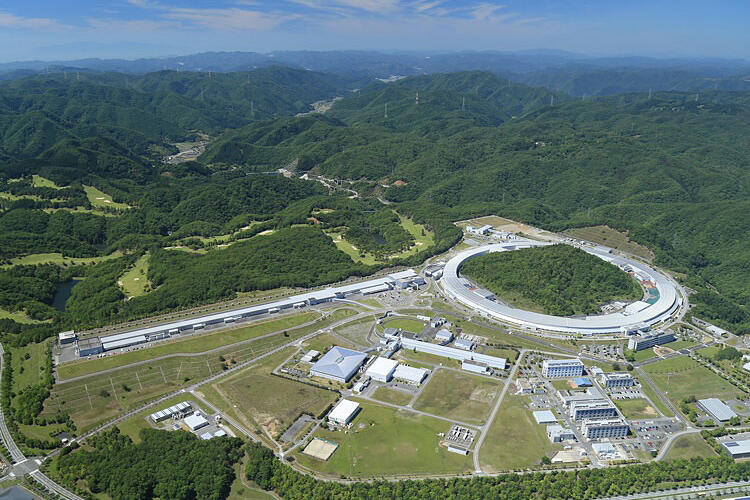
Provided by RIKEN SPring-8 Center (RSC)
Japan has numerous large facilities that foster the advancement of Japanese science and technology by producing exceptional results at a global level. This installment of the series 'Exploring megascience' delves into reality through on-the-ground research featuring the large synchrotron radiation facility known as 'SPring-8,' which is regarded as one of the world's Big Three, and an X-ray free-electron laser facility 'SACLA' located on a neighboring site. These facilities are operated by RSC and are collaborative research platforms aimed at uncovering the roots of the microscopic world, including the fine structures and phenomena of substances. Many universities, research institutes, and enterprises use these facilities, contributing to the advancement of science and industry.
A doughnut-shaped building that stands out amidst the greenery
After alighting the Sanyo Shinkansen bullet train at Aioi Station (Aioi City, Hyogo Prefecture), there is a local bus ride up a steep hill for about 30 min. As the bus emerges from a lengthy tunnel, the scenery outside the window changes drastically, and a verdant town comes into view, evoking a vision of the near future. This is Harima Science Garden City, which straddles Tatsuno City, Kamigori Town, and Sayo Town in Hyogo Prefecture.
Since the 1980s, this area has been developed as a 'high-dimensional functional city that promotes harmony among people, nature, and science.' It encompasses schools, research facilities, medical institutions, and other facilities. One that particularly stands out among them is SPring-8. The doughnut-shaped building surrounds the 341-meter-high Mt. Miharakuriyama. It has a diameter of 500 m and is 2.5 times the size of the Tokyo Dome. One circle around this building is equivalent to a distance of approximately 1,500 m.
SPring-8, which has been in operation since 1997, has an extensive track record. In recent years, the Japanese asteroid probe 'Hayabusa 2' conducted non-destructive CT scans and analyses of samples returned from the asteroid Ryugu and revealed their internal structures and mineral distributions, including pyrrhotite. This garnered attention, suggesting that these minerals may have formed on the outer rim of the early solar system.
In April of this year, Fukui Prefectural University announced its success in visualizing bone tissue in the fossil of the 'Fukuiraptor' dinosaur found in Japan. The non-destructive CT scan from SPring-8 was also utilized here. The results were comparable to those obtained by the conventional method in which thin fossil slices are prepared, which requires substantial time and effort, and examined under a microscope. This method is considered highly effective for research involving a limited number of valuable specimens.
'Synchrotron radiation' is a special type of light that is capable of such non-destructive analysis. The donut-shaped design of the SPring-8 building aids in generating this synchrotron radiation. At SPring-8, electrons are accelerated to an enormous energy level of 8 gigaelectron volts (one giga is equal to one billion). The trajectories of the electrons, which travel at nearly the speed of light, are bent by magnetic fields to generate high-intensity synchrotron radiation. Electromagnets are positioned to ensure that the trajectories of the electrons form a circle, enabling the successive emission of powerful synchrotron radiation.

Precise measurement with suppressed thermal expansion: 57 beamlines in operation
Synchrotron radiation covers a wide range of wavelengths, including infrared, visible light, ultraviolet, X-rays, and gamma rays. SPring-8 primarily uses X-rays to capture the images of various substances. The intensity of these X-rays is more than 10 million times higher than that of X-rays used for medical examinations. This high intensity enables us to observe nano-scale fine structures (approximately one billionth the size of a meter) that cannot be observed even with a microscope.
On entering the SPring-8 building, you will notice numerous pieces of equipment. The experimental hall is a circular zone with walls on the inside and outside. However, when you look into the distance, you can clearly see that the building is curved due to the absence of walls in the circumferential direction. Because precise measurements are conducted in a large facility, it is specifically designed to minimize the effects of thermal expansion and humidity under high temperatures.
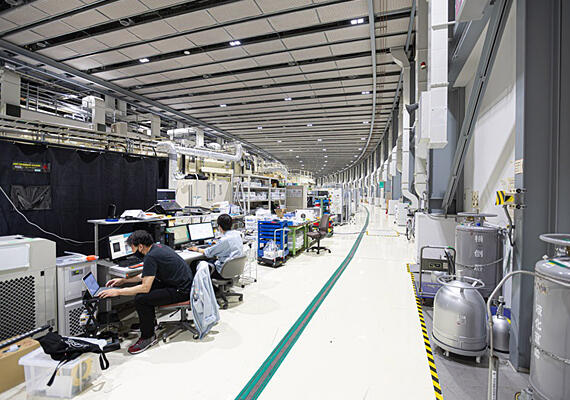
The experimental hall does not have any large walls; instead, there are many square rooms. These rooms serve as laboratory rooms, and synchrotron radiation can be introduced in each room. Researchers set up their experimental apparatus in these rooms and carry out experiments according to their own objectives.

A staff member uses a bicycle to move around the vast facility (right).
At SPring-8, there are currently 57 beamlines in operation, and up to 57 different types of experiments can be conducted simultaneously. This contributes to the advancement of research in various fields such as life science, environment, and energy, and the development of new materials.
Useful for developing high-performance tires and maintaining infrastructure
A one-meter-thick wall is installed on the inner circumference of the experimental hall. Inside the wall, there is a storage ring that consists of a ring-shaped vacuum chamber with electromagnets. This storage ring is the actual main body of SPring-8.
The interior of the aluminum alloy vacuum chamber is hollow. Electrons, accelerated to 99.9999998% of the speed of light, pass through it. The number of electrons is approximately 10 billion. The electrons are focused into a beam and are allowed to circulate in the storage ring (which has a circumference of 1,436 m) 200,000 times per second. As a result, extremely intense synchrotron radiation is generated.

SPring-8 is also widely used by private companies. A typical example is the development of high-performance tires. In a research collaboration between Sumitomo Rubber Industries and the University of Tokyo, the internal structure of tires was thoroughly examined using X-ray analysis. By enhancing the internal structure, they were able to commercialize tires with 39% less rolling resistance and 6% higher fuel efficiency than those of conventional tires.
Furthermore, X-ray CT, which captures images using X-rays from various angles and converts the obtained images into 3D images through computer processing, achieves 1,000 times higher accuracy than medical X-rays. During highway repairs, samples are collected and analyzed in detail using X-ray CT to assess the deterioration of the highway. SPring-8 is also useful in infrastructure maintenance and management, including prompt repairs achieved through simulation using the supercomputer 'Fugaku.'
Capturing instantaneous phenomena of atoms and molecules
Adjacent to SPring-8 is a slim 700-meter-long building that houses the X-ray free-electron laser SACLA. SCALA commenced operation in March 2012. 700 m is approximately equivalent to the length of seven vertically arranged soccer fields. Even when standing to the side, it is impossible to see all the way to the edge.
Similar to SPring-8, various pieces of equipment are installed in the building. If you look along the walls, you will see long pipes called accelerator tubes that extend along the building. A high-quality electron beam is efficiently accelerated by an electron gun, reaching speeds of up to 99.9999998% of the speed of light in the accelerator tube.

Provided by RSC

There is a wall at the end of the accelerator, but the tube through which the electrons pass continues beyond it. A series of devices called undulators, equipped with a large number of magnets, are lined up ahead. The accelerated electron beam meanders through this device multiple times to generate X-ray laser beams. The synchrotron radiation generated at SACLA is a billion times brighter than that generated at SPring-8.
As it is possible to make observations using extremely short flashes of 100 trillionths of a second, images of fast-moving atoms and molecules can be captured without blurring. Instantaneous phenomena can be recorded as a video by stitching these flash images together. This allows us to capture even the movement of atoms and molecules during chemical reactions, which were previously impossible to observe.
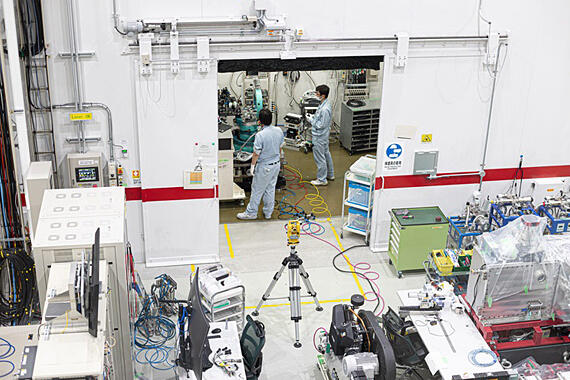
Numerous achievements have been made by utilizing this characteristic. For instance, the use of SACLA to capture photosynthesis in plants and unravel its mechanism at the molecular level is expected to provide valuable insights for the realization of artificial photosynthesis. Furthermore, investigating the motion of water generated in fuel cells has contributed to the advancement of hydrogen vehicles through the development of smaller and more efficient fuel cells.
Integration with data science at SPring-8-II with half the power consumption
SACLA and SPring-8 are connected, and the electron beams produced at SACLA are transmitted to SPring-8. Previously, different light sources and accelerators were used; however, since 2021, the system has been upgraded to directly transmit the electron beams accelerated by SACLA's accelerator to the storage ring of SPring-8.
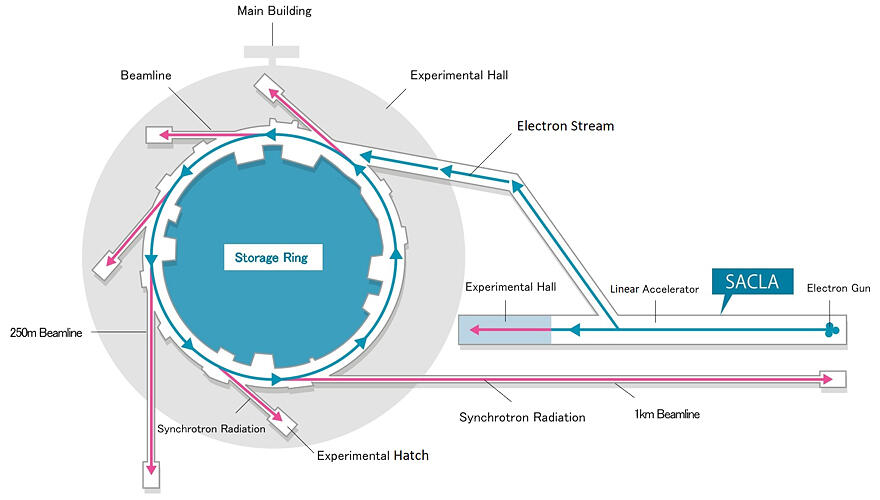
Provided by RSC
The reason for sharing the light source is to reduce energy consumption; however, there are also other reasons for doing so. There is a major renovation plan for SPring-8-II, the successor to SPring-8. Even after being in operation for more than a quarter of a century, SPring-8 continues to maintain its global presence as the world's most powerful X-ray production and observation facility. However, to adapt to the new era, the focused electron beams at SACLA are indispensable.
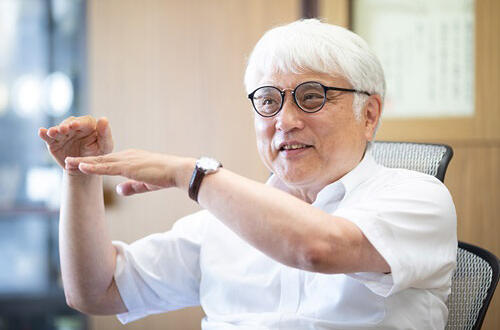
Tetsuya Ishikawa, Director of RSC shared his vision: "Our goal for SPring-8-II is to reduce power consumption by half and produce X-rays that are 100 times brighter than those produced at SPring-8." If power consumption could be reduced by half, there is no doubt that carbon dioxide emissions could be reduced while keeping costs down.
Moreover, once SPring-8-II is completed, it is expected that experiments that previously required about three years to complete at SPring-8 can be completed in just five days. This will increase the number of teams that can use the facility, making it more easily accessible to small and medium-sized enterprises. This, in turn, will lead to further advancements in the sophistication of research and manufacturing.
Ishikawa believes that the renovation will bring another significant benefit. "That is the integration with data science. By closely analyzing big data, there is the potential to gain unexpected scientific insights."
If large volumes of data could be obtained within a short time at SPring-8-II, it would be possible to produce highly accurate simulations and perform new scientific research by analyzing the data in collaboration with 'Fugaku' and other facilities. "We believe that it is crucial for scientific research to contribute to the overall well-being of people within society. We will establish and operate a research infrastructure for this purpose," Ishikawa said confidently.
Original article was provided by the Science Portal and has been translated by Science Japan.




